Best Endpoint Management Solutions in 2024
Today’s organizations couldn’t perform effectively without the use of remote devices. Managing these can be a headache for even the most advanced IT staff. Adopting an endpoint management system can alleviate this issue.
We will discuss what endpoint management is and which solutions are the best for your business.
- Part 1 :Core Concepts You Need to Know About Endpoint Management Solutions
- Part 2 :Why is Endpoint Management Important to Your Business?
- Part 3 :Key Functions of An Endpoint Management Software
- Part 4 :Best Endpoint Management Software for Business in 2024

- Part 5 :Comparison of Endpoint Management Solutions
- Part 6 :Conclusion
1Core Concepts You Need to Know About Endpoint Management Solutions
Endpoint management is the processes and technologies used to oversee all the IT in an organization. They’re called endpoints and include devices, laptops, networks, and servers.
The primary goals of endpoint management are to maintain the highest levels of security, know where any asset is at any given time, and have the ability to update patches when required.
To effectively achieve all of this, a company needs endpoint management software.
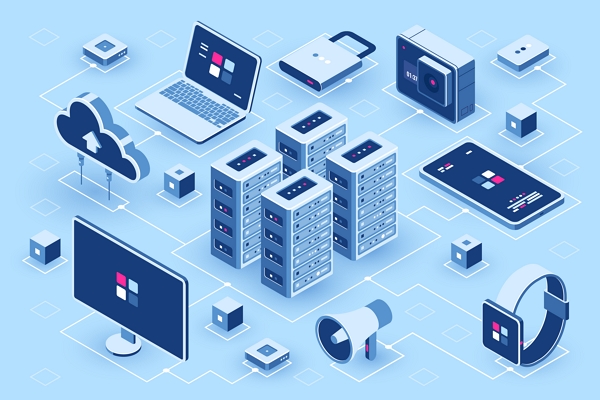
What is Endpoint Management Software?
Endpoint management software allows IT departments to oversee every device in the organization from a centralized platform. This allows one team or even one person to monitor, maintain, secure, update, and configure every device.
Understanding UEM (Unified Endpoint Management)
Unified endpoint management (UEM) combines mobile device management (MDM) and enterprise mobility management (EMM). It doesn’t matter if the devices are company-owned or employee-owned or if the software is Android, iOS, or Windows. A unified management system can oversee all of them from one central platform.
Endpoint Security
One of the biggest challenges for an organization with multiple endpoints is that any one of them can open the door for criminal cyber activity. Endpoint security is a comprehensive way to safeguard every endpoint device. It’s done by utilizing the latest in machine learning, behavioral analysis, and signature-based detection.
2Why is Endpoint Management Important to Your Business?
Endpoint security has risen to be one of the top concerns for businesses globally as they explore ways to ensure the security of their data and tech infrastructure. Some of the reasons why it is important for your business include the following.
1. Rising Cases of Cybersecurity Attacks
In 2019, the FBI, in its Internet Crime Report, revealed that reported cybercrime complaints surpassed 300,000 and cost more than $4.2 billion. Fast forward to 2021, the report indicates at least 847,376 complaints costing $6.9 billion or more. These numbers point to an upward trend in cybersecurity attacks, signaling the need for businesses to have an endpoint management strategy in place to ensure that they can fend off consistent threats.

2. More Flexibility on Employee-Owned Devices
We are in the age of remote and hybrid work, and more businesses will continue to shift to this working model. According to Technavio’s report, the global bring your own device (BYOD) market is expected to increase in size by USD 69.07 from 2021 to 2026, hence more exposure to threats. Distributed teams mean less control over the endpoints, creating further vulnerabilities that hackers may look to exploit.
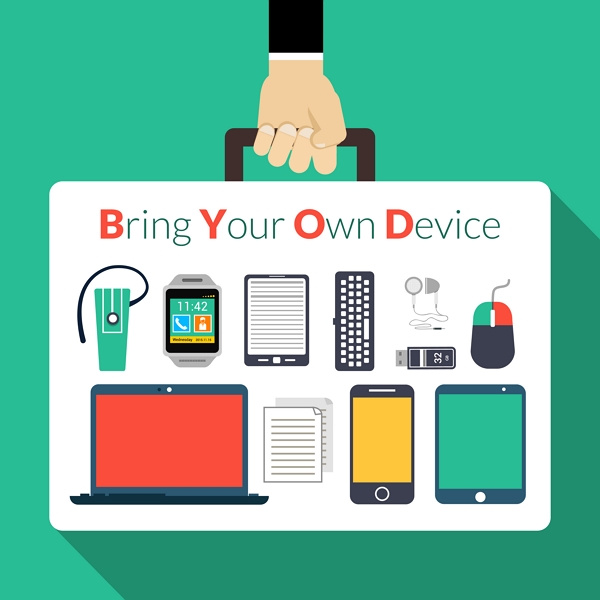
3. Increased Device Deployment
In addition to the impact of remote work, businesses are also adopting more devices into their workflows to ensure a better work efficiency and services.
For instance: Healthcare industries have been using wearable devices to monitor patients’ health status, so they can provide timely treatment. Retail businesses also deploy more digital signage, self-service kiosks, and staff work devices to create more convenient and interactive shopping environment, while increasing store productivity.
However, this trend also presents challenges for industries in terms of managing their fleet of devices without significantly increasing IT costs.
3Key Functions of An Endpoint Management Software
The endpoint management software you choose for your enterprise must comprise certain features that help you stay vigilant and protect your corporate network. The endpoint management software you implement should be able to;
1Remotely Manage and Monitor Endpoint Assets
Endpoint management software gives technicians the flexibility to remotely manage and monitor all the devices on one centralized console, which allows them to provide timely maintenance without going onsite. They can also monitor screen displays, data traffic, device status and health to identify issues and potential risks.
When deploying a new fleet of devices, instead of configuring them one by one, technicians can create a predefined device provisioning template to push secure settings automatically to devices, saving time and effort spent on repetitive work while making sure every device is taken care of.
2Enforce Security Policy on Devices
Security policies are proactive measures that help to prevent data breaches or leaks right from the source.
Technicians can configure dedicated operating environments to ensure that security principles, such as the principle of least privilege and the use of security authentication measures like lock screen passwords and multi-factor authentication (MFA), are followed. Other measures also include application blocklists and data loss prevention policies (DLP).
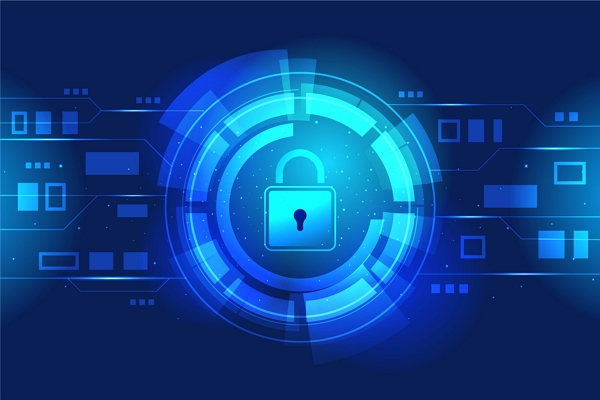
3Deploy Patches and Ensure Device Compliance
Patch updates help to keep endpoint devices up to date and fix issues that could compromise security. This process is important for addressing vulnerabilities that could be exploited by cyber attacks.
An endpoint management software should also allow you to identify any devices that are not compliant with the latest patch updates.

4Install and Update Applications or Operating Systems on Devices
Outdated operating systems on endpoint assets might be exploitated by malicious hackers to infiltrate a network.
To prevent this, it is important to use an endpoint management software that enables you to automatically update operating systems and applications from a central location, rather than leaving the risk of a security breach open to chance.
5Threat Detection and Remediation
Endpoint management software can alert IT staff to potential issues before they become more serious problems. This feature is often paired with automated workflow capabilities, which can troubleshoot problems on the spot when alerts are triggered.
By addressing issues in this way, IT staff can reduce device downtime more efficiently without the need to send people onsite.
4Best Endpoint Management Software for Business
Debating which endpoint management software to go for to ensure your business or customer data protection? Check out the following recommendations.
1 AirDroid Business
AirDroid Business empowers businesses, IT professionals, and managed service providers to remotely manage unattended Android devices from a central platform. It is a fast, efficient, and safe mobile device management software that will simplify device access and control to ensure adherence to safety policies and minimize risk and misuse.
- "AirDroid business users have many extremely positive things to say about the platform. For starters, it’s easy to use, from adding devices to the fact that even someone with limited experience can operate it. Others mention that it’s packed full of features that can be added on as an organization grows its needs, and it’s very cost-effective, as businesses only pay for what they use."
------This feedback is given by a real user, highlighting his experiences and satisfaction with the platform.
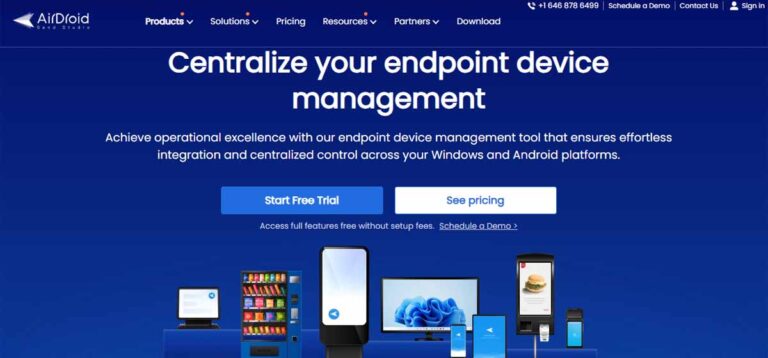
Key Features
- Alerts and automated workflows: receive alerts when issues are detected and execute automated workflows to solve them upfront
- Broad compatibility: support a wide range of Android-based endpoints, including phone, tablet, POS, kiosk, digital signage, rugged devices, and custom devices
- Security policies: enforce strong lock screen password, multi-factor authentication, application data loss prevention (DLP) policy to protect data security
- Unassisted and easy remote control: provide powerful remote control features and real-time monitoring on unattended devices without rooting
- Application management services: keep business apps up to date by scheduling rollouts based on device group, device type, location and minimize security risks.
- Kiosk Mode: lock Android devices into single or multi-app mode, whitelist websites, and block unauthorized network access to reduce IT workload on device misuse.
- Centralized dashboard: A cloud-based management interface that serves as a control center for every endpoint. It’s the ultimate in unified endpoint management.
Pricing
- Begin with a 14-day free trial, then choose from basic, standard, or enterprise. You pay per device, and each level provides more features.
Pros
- Cost-effective as you only pay for what features you use and the number of devices
- Real-time monitoring allows for live tracking of devices
- Robust security features with end-to-end encryption, ensuring sensitive data is protected
- Responsive and helpful customer support provides real-time assistance
- Offers user-friendly interface
Cons
- Only supports Windows and Android devices
2 ManageEngine
ManageEngine is a cloud-based IT platform that provides solutions to secure business endpoints, improve network security, and deliver convenient IT services. It also offers solutions tailored to specific industries to ensure the security of endpoints.
The goal of ManageEngine is to make IT management easy to monitor endpoints, manage software licensing, and reduce data leakage and theft. This is achieved through an intuitive user interface that simplifies endpoint management and makes it more efficient.
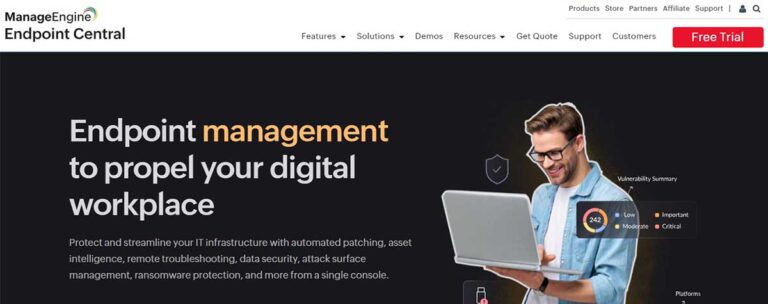
Key Features
- Remote assistance
- Easy customization
- Comprehensive mobile device management
- Vulnerability management
- Data loss prevention
Pricing
- ManageEngine’s Endpoint Central has a free edition for SMBs, a professional edition with an annual fee that covers up to 50 computers, an enterprise edition that covers all desktop and laptop management across WAN, and a UEM edition that covers all endpoint devices for an annual fee.
Pros
- Comprehensive device support, including desktops, laptops, and smartphones
- Intuitive dashboard is easy to navigate
- Streamlines the process of keeping software updated
- Competitive pricing
Cons
- Customer support can be slow at times
- Complex deployment process requires expertise
3 Hexnode
Hexnode is an ideal SaaS management service for businesses looking for a pay as you grow type of endpoint management solution. You can also try out the service with a 14-day free trial.
Hexnode will enable your business to implement unified device management solutions covering a host of devices, including Android and iOS phones, Windows and Mac computers, TVs, and more. It features customizable solutions that allow you to free your IT team and set up your enterprise for success.

Key Features
- Kiosk Mode
- App management
- Remote control
- OS update management
- Geofencing
Pricing
- Hexnode has four pricing categories, charged per device, and all come with a 14-day free trial. Pro is for advanced MDM and kiosk essentials, enterprise is for basic UEM and advanced kiosk, ultimate is for advanced UEM and complete kiosk, and ultra is for complete UEM and kiosk.
Pros
- Cross-platform support, including Android, Windows, iOS, and macOS
- Security features like remote wipe, geofencing, and application whitelisting
- Supports both cloud-based and on-premises deployments
- Responsive customer support
Cons
- Costs increase as features are added
- Integration challenges with non-MDM Systems
4Atera
Atera is an all-in-one IT platform that avails multiple tools to enhance your endpoint assets management efforts. This cloud-based platform allows you to easily integrate with other tools in your enterprise to ensure efficient security of your data and controlled management of devices on the network.
With Atera, you can automate IT scripting to create more possibilities for your IT team and empower them to do more. Enhance threat monitoring, response, and troubleshooting of issues to offer a seamless customer experience.

Key Features
- Remote access
- Network discovery
- Patch management
- IT script automation
- Remotely monitoring and managing unlimited devices
Pricing
- Atera offers a 30-day free trial. After that, there are six pricing levels based on the features required: MSP-Pro, growth, and power; then IT Department-Professional, expert, and master.
Pros
- Ease of use due to its intuitive platform
- Automation capabilities streamline repetitive tasks
- Detailed reporting tools
- Cost predictability due to its subscription model
Cons
- Lacks some advanced endpoint management functionalities
- Integration challenges with other tools.
5NinjaOne Endpoint Management
NinjaOne is known for its integration capabilities, enabling your enterprise and IT team to work in auto mode and stay on top of network threats. The cloud platform prioritizes IT team efficiency and enhances users' productivity.
With NinjaOne, you can free up resources in IT department to focus on strategic tasks by automating workflows easily from its dashboard.
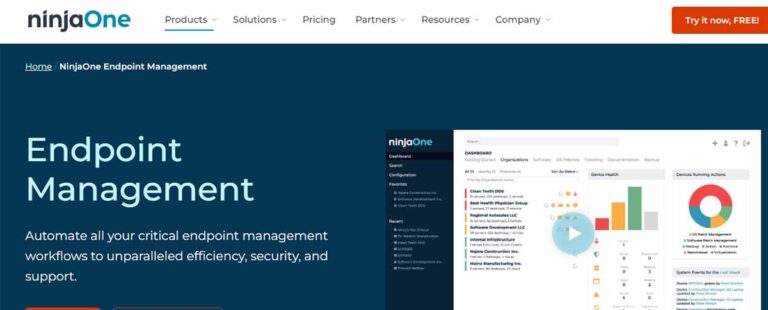
Key Features
- Patch management
- Business data backup
- Software deployment
- Remote access
- IT asset management
Pricing
- NinjaOne provides a custom quote for every organization. The cost is determined by the number of devices to be covered and any additional features.
Pros
- Quick setup process for fast deployment
- Comprehensive reporting tools
- Simplifies device management
- Automates routine tasks such as patch management and software updates
Cons
- Customer support response times can be slow
- Lagging during peak times
6Citrix Endpoint Management
Citrix Endpoint Management is a cloud platform that helps to secure distributed networks by modernizing IT security, providing a VPN alternative, and protecting apps and APIs. Its desktop as a service (DaaS) feature aims to help IT teams manage multiple devices easily and improve the user experience.

Key Features
- Zero trust network access without a VPN
- App delivery and security service
- Web app and API protection
- Behavior analytics
Pricing
- Citrix Endpoint Management has three pricing plans: stand-alone, workspace premium, and workspace premium plus. The cost increases based on the number of features required.
Pros
- Unified management of various endpoint types
- Seamless Integration with other Citrix Products
- Robust security features such as multi-factor authentication (MFA) and encryption
- Flexible deployment options, cloud-based or on-premises
Cons
- Users have found certain aspects less customizable compared to other solutions
- Pricing may be higher compared to other endpoint management solutions
7Microsoft Intune
Microsoft Intune is a popular endpoint management software for enterprises already using the Windows platform to manage their mobile devices.It is especially well-suited for enterprises that allow bring-your-own-device (BYOD) practices due to its ease of integration. Its single sign-on automation feature makes device integration fast and efficient.

Key Features
- Multi-factor authentication
- Integration with Microsoft ecosystem
- Remote monitoring and management
- App management
Pricing
- Microsoft Intune has an initial pricing plan charged per device; any additional features are charged as add-ons and can be mixed and matched.
Pros
- Integration with Microsoft ecosystem
- Strong security policies, including conditional access
- Supports a wide range of devices
- Flexible licensing options
Cons
- Initial configuration settings appear complex
- Limited advanced reporting features
8Ivanti
Ivanti Endpoint Manager integrates the management of all end-user platforms and mobile devices on a large scale in a unified endpoint management experience. It allows IT staff to fix issues and automate app and OS deployments.
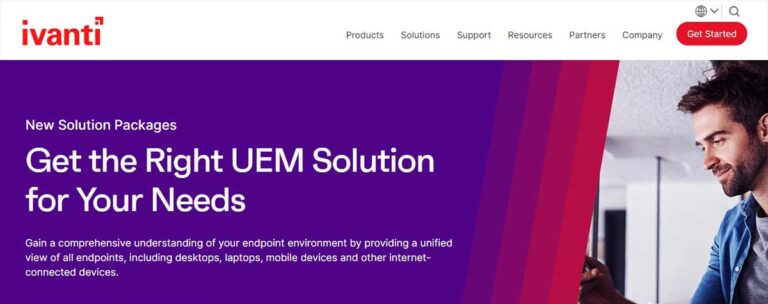
Key Features
- Centralized management
- Automated software deployment
- User profile management
- Detailed reporting and analytics
- Data normalization
Pricing
- Ivanti provides custom quotes for every organization. The cost is based on specific product and environment needs and the number of devices to be covered.
Pros
- Remote functionality minimizes the need for desk-side visits
- An intuitive graphical console allows IT administrators to manage devices effectively
- Supports a wide range of operating systems and device types
- Automates many tasks, such as software deployment and patch management
Cons
- Complex initial setup
- Lag issues with a large number of devices
9Google Endpoint Management
Google Endpoint Management is a feature of Google Workspace. It provides IT administrators with tools to manage applications, enforce security policies, and monitor device compliance, all from a centralized console.
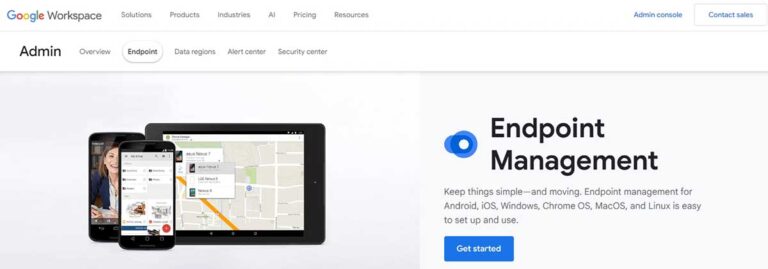
Key Features
- Centralized management
- Context-aware access
- Reporting and analytics
- Application management
Pricing
- Google Workspace covers Google Endpoint Management if the organization is on the Business Plus plan, which is charged monthly per user.
Pros
- Seamless integration with other Google tools
- Cost-effective as it’s included in Google Workspace
- Facilitates Bring Your Own Device (BYOD) policies
- Intuitively designed to be user-friendly
Cons
- Dependency on Google Workspace
- Limited advanced features
5Comparison of Endpoint Management Solutions
Based on user reviews and comments, here’s how eight of our nine reviewed products compare with each other.
| Star Rating | Meets Requirements | Ease of Use | Ease of Setup | Ease of Admin | Quality of Support |
|---|---|---|---|---|---|
| AirDroid Business | 9.4 | 9.6 | 9.5 | 9.6 | 9.5 |
| ManageEngine | 8.7 | 8.6 | 8.6 | 8.7 | 8.3 |
| Hexnode | 9.1 | 9.0 | 9.0 | 9.1 | 9.3 |
| Atera | 8.9 | 9.2 | 9.1 | 9.0 | 9.0 |
| NinjaOne Endpoint Management | 9.1 | 9.2 | 9.3 | 9.3 | 9.3 |
| Citrix Endpoint Management | 8.3 | 7.5 | 6.3 | 7.5 | 7.9 |
| Microsoft Intune | 8.9 | 8.6 | 8.2 | 8.5 | 8.3 |
| Ivanti | 8.4 | 7.5 | 6.9 | 8.0 | 8.0 |
| Google Endpoint Management | Not enough reviews to generate ratings |
6Conclusion
Endpoint management is vital, and the only way to ensure it’s done properly is to utilize the best endpoint management solutions in the market. Security, deployment, monitoring, and reporting are all features that need to be added at a minimum; adding new features occurs as business needs grow. As you can see, AirDroid Business tops the list of all platforms.




Leave a Reply.